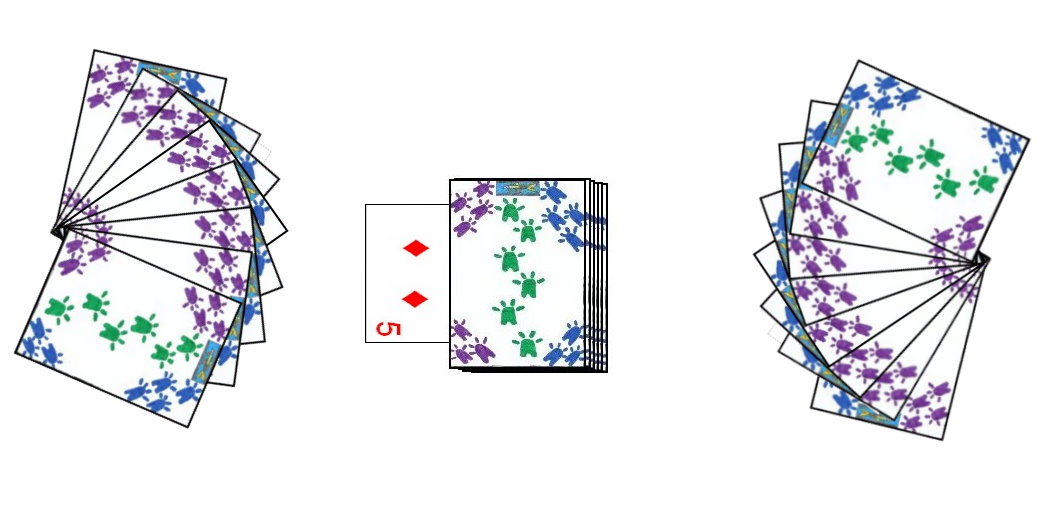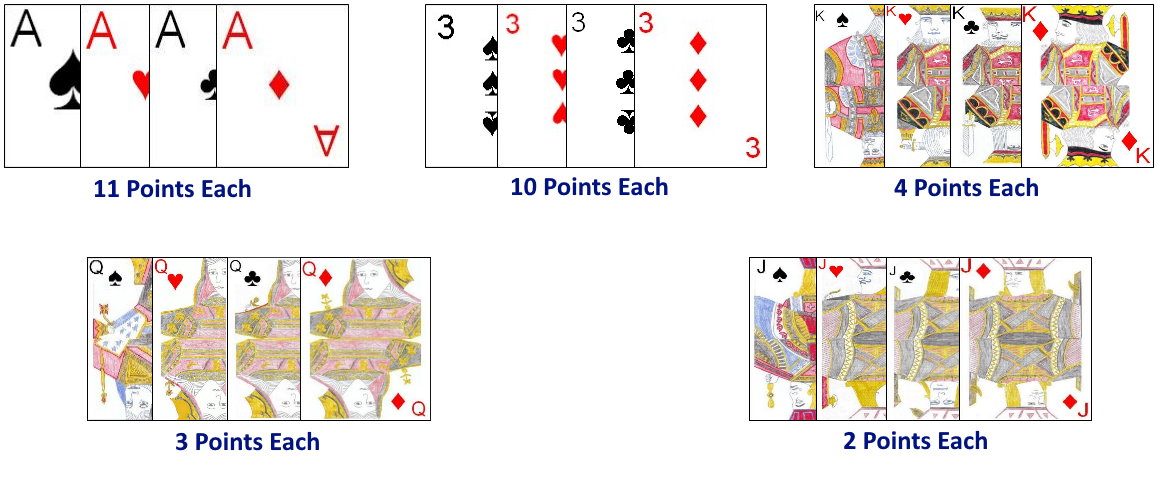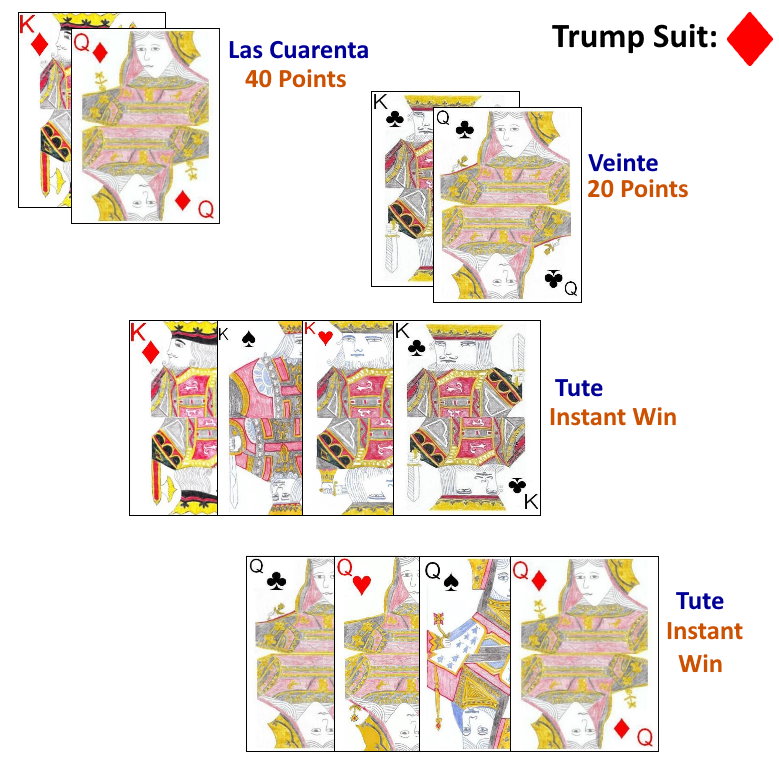Differing number of Game Points: In order to make for a shorter or longer game, some players prefer to play to a different number of game points, with 3 or 8 points a common method. Another option which is sometimes used is to continue playing until one team has a commanding lead of two games over the opposing team.
Tute Independiente: Tute Indpendiente is a variant of Tute designed for two or three players, each player playing independently. The game uses the same deck as in the four player version of Tute and the same ranking of cards in that deck.
Determination of seating positions and first dealer can be determined in a variety of ways, with draw for high cards a common method. Each player would draw one card from the shuffled deck. Each player would take a seat at the table in the order of the rank of cards drawn, from highest to lowest. The player drawing the highest card of all is set as the first dealer. After each hand, the role of dealer rotates around the table in a counter-clockwise direction.
Once the players are seated and first dealer selected, the dealer should thoroughly shuffle the cards and pass it to the player at his left to cut. After the cut the dealer begins dealing the cards starting with the player to his immediate right and continuing in a counter-clockwise direction. He deals the cards one-at-a-time and face-down continuing until each player has 10 total cards. He then deals the next card face-up on the table, and places the remainder of the deck (called the stock) partially covering this face-up card. The suit of this card determines the trump suit for this hand, with all cards in that suit set as trump cards during the hand.
The player to the dealer's immediate right leads the first card to the first trick. The rules for playing to a trick are identical as in the four player version of Tute as described above. After a trick has been won, the players will each draw a card from the face-down stock. The winner of the trick draws the first such card and the remaining players will also draw in a counter-clockwise direction from the winner of that trick. In the two player variant of Tute Independiente, the players continue to draw until the stock has been exhausted, with the last draw being the face-up trump indicator card. In the three player variant, the players will each draw a card in this way after the first three cards, which will then leave one card remaining, the face-up trump card which is not drawn and remains face-up on the table until the end of the hand. As in the four player version, the players then play out the rest of the hand using the remaining cards in the hand.
In all other aspects, Tute Independiente is played identically to the standard four player version as described above. After a set number of hands (say 12), the player with the most Game Points accumulated from game wins is set as the overall session winner.
Tute Habanero: Tute Habanero is a two player variant of Tute which is
fairly common. This two player version is actually an older game than standard Tute, however, the four player variant described above is generally more
commonly played.
Tute Habanero is also traditionally played using the Spanish deck as used in the
four player variant, and if such a deck is not available the more common French deck can be used by removing all eights, nines and tens from the deck. The ranking of the cards in the resultant deck is as follows (from high to low): Ace, 3, King, Queen, Jack, 7, 6, 5, 4, 2.
Determination of the first dealer can be performed using a variety of methods, with a draw for high card commonly performed. Both players would thus draw one card from the shuffled deck and whichever player draws a higher ranked card would be set as the first dealer. If both players draw cards of the same rank, they should each draw another card, continuing until, in this draw, one player draws a card of a higher rank than the other so drawn. After each hand, the role of dealer is taken by the player who wins the last trick of the previous hand.

Once the first dealer is determined, he should thoroughly shuffle the deck and offer it to his opponent to cut. After the cut, the dealer begins dealing the cards, one at a time and face-down, starting with his opponent. Once each player has eight total cards, the dealer then deals one more card face-up to the middle of the table, which is used to determine the trump suit for the hand. This card and all other cards of this same suit are considered to be of the trump suit for the hand. After dealing this trump card, the dealer places the remainder of the pack (called the stock), face-down
perpendicular to the designated trump card, partially covering it.
There are essentially two phases of this game. The first phase has a relaxed set of rules regarding the play of tricks, but during the second phase these rules are much more stringent. During the first phase the leader of each trick selects any card to lead to the trick. His opponent then may play any card of his choice to complete the trick. The highest card of the trump suit played to the trick (if any) wins the trick. If the trick contains no cards of the trump suit the trick is won by the player of the highest card in the suit originally led to that trick. The opponent of the dealer leads the first card to the first trick, thereafter, the winner of each trick leads the first card to the next trick.
After the stock has been exhausted (see below) the rules for play to a trick change drastically. During this second phase, the leader to a trick may still play any card of choice from his hand, however the rules for the allowable plays to an existing trick are as follows:
- If the player has a card of the same suit as that originally played to the trick, he must play it. If he has any cards in that suit which are of higher rank, he most play such a card, otherwise he may play a card of that suit in a lower rank.
- If the player has no cards of the suit originally led to the trick but had cards of the trump suit, he must play the trump card to the trick.
- If the player has neither a card of the suit originally led to the trick or a card in the designated trump suit, he may play any card from his hands to the trick.
The rules for who wins a particular trick are similar to those in the first phase. Each trick is won by the player of the highest card in the trump suit, if it contains any. If the trick contains no cards of the trump suit, the trick is won by the player of the highest card in the suit originally led to the trick. The winner of the trick places the cards which formed the trick in a face-down pile of cards, called the baza, which will be examined at the end of the hand for scoring purposes. The winner of the trick takes the top card of the face-down stock and his opponent then takes the next card from the stock, to replenish the hands back to eight cards. The winner of each trick then leads the first card to the next trick, which may any card of choice from his hand.
After the draw, the winner of a trick is entitled to make any announcements (called to sing) of special point scoring combinations before leading to the next trick. The cards comprising the combination must be cards currently found in the player's hand. Declarations can no longer be made once the stock contains two or less cards. The following are the legal announcements:
- Las Cuarenta:
This is a declaration consisting of the King and Queen of the trump suit. This declaration earns the player declaring the combination 40 points at the end of the hand.
- Viente:
This is a declaration of a King and Queen of the same suit, but not in the trump suit. This declaration earns the player making this declaration 20 points.
- Tute:
This is a combination of either all four Kings or all four Queens. This combination, when made, instantly wins the game for the player.
Exchanging for the Trump Card: If the original exposed trump designator card is of rank Ace, 3, King, Queen or Jack, a player may exchange the Trump seven from his hand for this trump card, replacing the trump designator card with the seven. If the current exposed trump designator card is of rank 7, 6, 5 or 4 a player having the two of the trump suit may, on his turn, exchange the two for the exposed trump designator card. This exchange can only be made after a player has won a trick but must occur while there are still two or more cards remaining in the stock.
Eventually the stock will be depleted, with the player taking the last two cards from the stock. The last card drawn will be the current designated trump card. At this juncture of the game, the player continue playing using the cards in hand, and not drawing cards to replenish the hand.
After all the tricks have been played and won, each player examines the cards found in his baza to calculate his final score for the hand. The following chart shows the scores for each card found in the deck:
| Card | Point Value |
|---|
| Each Ace | 11 |
| Each 3 | 10 |
| Each King | 4 |
| Each Queen | 3 |
| Each Jack | 2 |
| 7, 6, 5, 4, 2 | 0 |
|
|
 |
Winning the last trick of the hand also earns the player doing so a 10 point bonus.
If either player manages to win 101 or more accumulated points at the end of
a hand, that player is declared the winner. If neither player manages to earn at least 101 points
at the end of each hand, another hand is then dealt. If both players, after the end of a hand have earned over 101 points, the player with the higher total accumulated points is declared the game winner.
Tute Corriente: Tute Corriente is another two player form of Tute, which is also played very similarly to Tute Habanero. In fact, Tute Corriente is played identically to Tute Habanero with the following differences:
- During the initial deal, each player is dealt six total cards, and each player will
retain this many cards in hand during the hand until the stock is exhausted.
- Capote:
Immediately after the stock is exhausted, and when the stricter rules are then adhered to, either player may declare
"Capote". This is a declaration indicating that player is indicating he will win the last six tricks during the hand. If he does manage to win all the remaining tricks, he wins the game outright, irregardless of how many points he or his opponent currently has or wins during the hand. However, if his opponent manages to win even one of these last tricks, his opponent is automatically set as the winner of the game.
In all other aspects Tute Corriente is played identically to standard Tute Habanero as
described above.
Tute Americano: Tute Americano is a two-player version of Tute which is often played in the Americas. Tute Americano is also played identically to Tute Habanero, with the following differences from that game:
- Declarations of Tute are not honored in this variant and thus not used in Tute Americano.
- The rules for playing to a trick in the first phase are slightly stricter in Tute Americano, as follows:
- If the leader to the trick leads a card in the trump suit, if the opponent has a card in the trump suit he must play it, but is under no obligation to play a higher trump if he has lower cards in the trump suit. If the opponent plays a card other than the trump suit, he must later prove (by showing the cards as played from the bazas).
- If a trump card is led to the trick and the opponent does not have a card in the trump suit, he may play any card from his hand.
- If the leader leads a card in a suit other than the trump suit, during this first phase, the opponent may play any card of choice from his hand.
During the second phase, when the stock has been depleted, the same rules apply to playing to the trick as in Tute Habanero.
- 121 points or more are required before a player can be set as the designated winner of the game.
In all other aspects this game is played identically to Tute Habanero.
Havanian Tute: Havanian Tute is also a two player version of Tute, which is almost identical to Tute Americano but
is the version of Tute that is most commonly played in Cuba. The differences amongst this game and Tute Americano is as follows:
- The first player to exceed 100 points after one or more hands is declared the game winner.
- If a player believes, during the second or subsequent game, that his
score has reached or exceeded the exquisite 101 points, he may announce
this. In doing so, play immediately halts and each player totals the current points from prior hands and earned so far during the current hand. If the player so announcing has in fact reached or exceeded 101 points, he immediately wins the hand, regardless of how many points his opponent may have. However, if he has failed to reach at least 101 points, his opponent is immediately declared the winner instead, irregardless of the number of points that player
currently has accumulated.
- Similar to in Tute Corriente, a player in Havanian Tute has the option, when the stock has been depleted and each player has exactly eight cards, to declare Capote. This is a declaration indicating that the player is intending to win the last eight tricks during the hand. If he does in fact manage to win all the remaining tricks, he wins the game outright, irregardless of how many points he or his opponent currently has during this hand. However, if his opponent manages to win even one of these last tricks, that opponent is automatically set as the winner of the game.
In all other aspects Havanian Tute is played identically to Tute Americano as described above.
Copyright © 2015 CatsAtCards.com. All rights reserved.


 After all four players in turn have played one card to the trick the trick is examine to determine the winner. The player of the highest card in the trump suit wins the trick. If the trick contains no cards in the trump suit, the player of the highest card of the suit originally led to the trick wins the trick. Each partnership retains a face-down pile of cards won by his partnership in tricks, called his baza. The winner of each trick leads the first card to the next trick.
After all four players in turn have played one card to the trick the trick is examine to determine the winner. The player of the highest card in the trump suit wins the trick. If the trick contains no cards in the trump suit, the player of the highest card of the suit originally led to the trick wins the trick. Each partnership retains a face-down pile of cards won by his partnership in tricks, called his baza. The winner of each trick leads the first card to the next trick.
 Once the first dealer is determined, he should thoroughly shuffle the deck and offer it to his opponent to cut. After the cut, the dealer begins dealing the cards, one at a time and face-down, starting with his opponent. Once each player has eight total cards, the dealer then deals one more card face-up to the middle of the table, which is used to determine the trump suit for the hand. This card and all other cards of this same suit are considered to be of the trump suit for the hand. After dealing this trump card, the dealer places the remainder of the pack (called the stock), face-down
perpendicular to the designated trump card, partially covering it.
Once the first dealer is determined, he should thoroughly shuffle the deck and offer it to his opponent to cut. After the cut, the dealer begins dealing the cards, one at a time and face-down, starting with his opponent. Once each player has eight total cards, the dealer then deals one more card face-up to the middle of the table, which is used to determine the trump suit for the hand. This card and all other cards of this same suit are considered to be of the trump suit for the hand. After dealing this trump card, the dealer places the remainder of the pack (called the stock), face-down
perpendicular to the designated trump card, partially covering it.
